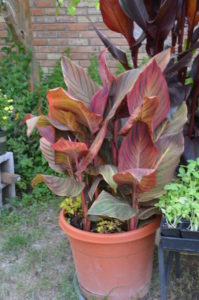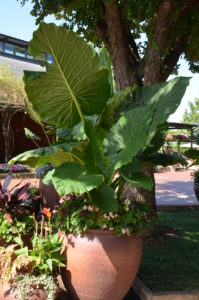Eventually, all potted plants outgrow their containers. This includes potted roses, Japanese maples and other small trees, shrubs, dwarf conifers, elephant ears (Colocasia, Alocasia), cannas, lotus, papyrus, and lots more. A rule of thumb is to transplant every 2 years in early spring before bud break. In the case of perennials and tropicals, this is a good opportunity to divide plants. Tropicals may need to be set back into a greenhouse until it is safe to move outdoors.
Plants tend to deplete the soil of nutrients and soil pH may change. Select a container large enough to provide adequate space for plant roots, one that is one or two sizes larger. New soil media should be well-drained and retain moisture. Add a one inch deep layer of coarse to medium sized gravel or other rocks in the bottom of the container for extra drainage.
Spread out plant roots and fill in around the roots with the remaining soil media. Press down firmly, but do not injure roots. For grafted plants such as roses, Japanese maples, or certain conifers, don’t bury the bud union. Settle the soil (media) in the container and finish filling to within 1 inch of the lip of the pot.
The container may be plastic or clay. During hot weather clay containers provide a cooler soil environment for roots compared to plastic pots. Clay pots usually dry out faster than plastic. Choose light colored pots so dark shades heat up faster. Thin plastic and clay pots may crack during freezing winters.
Set the container in a location with adequate light and good air circulation. Allow 2 feet or more space between containers for adequate sunlight and proper air movement. For example, roses should have 6-7 hours of direct sunlight. Don’t crowd plants too close together as this may create a favorable environment for disease and insect troubles.



 Posted in
Posted in 
